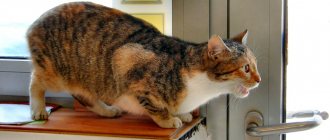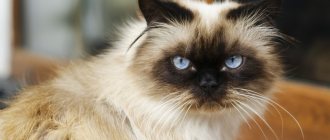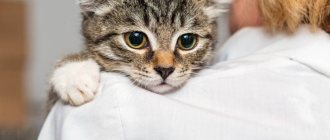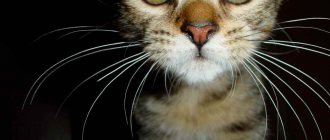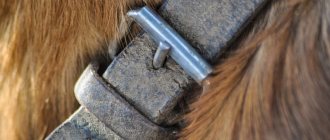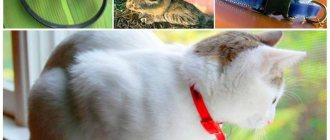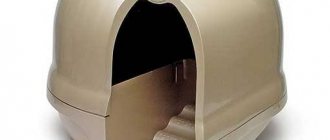Save the article:
If your cat suddenly changes her behavior, is capricious, or constantly wanders around the apartment meowing, then she is in heat. This is a natural process that occurs in the animal’s body and, provided the pet is in good health, does not require human intervention.
A cat's heat lasts for several days, but this behavior can be observed immediately before the process begins. During this period, the animal behaves demonstratively capriciously: it can lie down on the floor with its butt sticking out, rub against the floor, and close its eyes. The usual kind purring of a cat is replaced by persistent and inviting, or even completely unpleasant.
global $ads_google; //data-ad-slot=”2475549904″ $ads_google = empty($ads_google) ? false : true; ?> if ($ads_google == false) {?>
$ads_google = true; ?> } ?>
A loving owner should pay close attention to this process, especially if his pet is needed for breeding.
What is estrus
Estrus in a cat (estrus, estrous cycle, heat) is part of the sexual cycle, informing that the animal is ready to have offspring and is looking for a mate.
Changes occur in the body under the influence of hormones that put the cat into a state of “sexual heat.” The animal is looking for a male, while demonstrating characteristic behavior - meowing, rubbing against walls, crawling on the floor. In everyday life they say “the cat has gone on a spree.”
The sexual activity of females is seasonal and depends on the length of daylight hours. During the dark season (late autumn – winter), the cat’s body intensively produces the hormone melatonin. It suppresses the “power” of estrogen, the hormone that is responsible for sexual behavior. In the middle zone, daylight hours increase in March. Therefore, from the beginning of spring, less melatonin is synthesized in the cat’s body, and cats begin to have regular estrus.
Duration of “critical days”
The average duration of “critical days” is 5-7 days, but sometimes it can last up to 14-20 days. Due to the variety of factors influencing this process, it is almost impossible to determine how long a cat's first heat will last. Most often it goes faster, but it is better to start from average indicators.
If sexual activity exceeds 3 weeks or lasts less than 5 days, take your pet to a veterinary clinic for diagnosis. In the first case, there is a possibility of developing tumors or inflammation in the ovaries, and in the second - pathologies of the thyroid gland or ovarian hypoplasia.
How to tell if your cat is in heat
In fact, no one knows how a cat feels, whether it hurts during the hunt. But it is obvious that the changes taking place cause discomfort to the animal. A female in heat is hard not to notice or hear.
You can understand that a cat wants a cat by the following characteristic signs:
- Moves restlessly around the house. It seems that the pet does not stop moving and does not sit still.
- Rolls on the floor on his back, turns over his head, almost stands on his head.
- Appetite noticeably decreases.
- When a cat walks, it rubs against objects and furniture. Glands located on the body secrete pheromones intended for the cat.
- Shows increased affection for the owner and other animals in the family, rubbing against them.
- Some cats, usually affectionate, on the contrary, begin to behave aggressively towards the owner. They become capricious, unpredictable and sometimes behave inappropriately.
- You can tell that a cat is starting to walk by its “vocals,” which are very different from the usual. She begins to purr, scream, meow loudly. To an owner who has not yet seen his pet in heat, the screams will seem strange. These can be melodious calls, real screams, tragic and harsh sounds. This makes the owner want to immediately take the screaming cat to the veterinarian.
- During heat, a cat may mark outside the litter box, pee, or shit in inappropriate places. The smell of urine becomes stronger. The mark is a message to cats that “the female is ready.” Therefore, the more puddles an animal leaves around the house, the greater the chance that the males will “hear” her. An inexperienced owner may think that the cat has begun to go to the toilet more often and suspect cystitis or another disease of the genitourinary system. But these are marks.
- There is swelling of the vulva and clear watery discharge. Therefore, the pet often licks under its tail. Cats, unlike dogs, do not have bleeding. If blood appears under the tail or the color of the discharge turns green or brown, you need to contact a veterinarian - this is a pathology.
- You can tell that a cat is in heat by its characteristic posture. It looks like this - a female who has been on a spree raises her pelvis, arches her back, moves, tramples with her hind legs and moves her tail to the side to encourage the male to mate. It is scientifically believed that the female moves her hind legs as if she is “walking while standing still” so that her genitals sway up and down. This stimulates the male to push harder and increases the chance that ovulation will occur.
- The reaction is especially acute if it is stroked at the base of the tail. This is a 100% way to determine that a cat is in heat.
- He tries to run out into the street. Walks along the windowsill, often approaches the front door. And cats that have access to the street go on a spree for several days, leaving the house.
How to calm an animal
First of all, the owner must understand that it is driven by instincts, so you should not get angry or shout at the animal. Moreover, you should not hit him, you could cause harm to your health. Since it is possible to calm a cat in heat, pull yourself together. During this period, animals are very emotional. Try to talk to your pet as often as possible, pick her up and stroke her. Distract her with games, she needs to redirect her energy somewhere.
A good choice would be mechanical toys that arouse genuine interest in animals. Many owners note that if two cats live in the house, then this period passes painlessly. They just lick each other and play all day long, compensating for the discomfort. But it’s not always smooth here either. If the animals do not get along too well, then during this period the relationship may enter the stage of open conflict. In this case, it is better to separate them into different rooms so as not to harm each other.
Try to make the female sleep less during the day. Active games will help her get tired by night and go to sleep sweetly in the evening. Otherwise, invitation songs are provided. For the same purpose, limit or eliminate daytime feedings. A hungry animal will not go to sleep, but will run around and look for food. And in the evening, give her a bowl of food. After dinner, she will be more willing to go to the side.
You cannot lock an animal in a closet or toilet. It's a huge stress. Then an alarming cry for help will be added to the songs of dissatisfaction. Restricting movement is the worst option you can think of.
Do all cats show noticeable signs of heat?
Not every cat during heat shows signs of it. This is especially possible if there are several cats in the house and estrus has begun in a “subordinate”, timid female. The second option is that estrus occurs hidden in a cat that the owner had previously scolded and punished for “bad” behavior. During the hunting period, such animals try to hide, are not active, even lethargic.
There are females that will never show signs of hunting if there is no male nearby. Therefore, the owners of such “hidden” individuals cannot recognize the heat until a male is nearby.
Use of hormone-based medications
Mustachioed pets cope with this difficult time in different ways. Some need a little affection and attention to survive this period, while others suffer from unsatisfied desire, despite the efforts of their owners. If the usual methods of calming down are powerless, you will have to turn to special means, tablets, drops, options that help relieve tension. When mating is not planned, sterilization is the right option.
The principle of operation of drugs of this type
Only hormones, natural or synthesized, can effectively influence the onset of sexual heat. Progesterone enters the body during pregnancy. A dose of progestin preparations administered during the rest period suppresses the effect of follicle-stimulating hormone. Estrogen, which provokes sexual desire, does not enter the blood, and the period of sexual desire is blocked. If hormonal medications are used incorrectly, your pet may die.
Types of drugs
Hormonal preparations of this type are available in tablet form, as drops for internal use or application to the withers. An effective, high-quality product contains a complex of hormones. Veterinarians often prescribe the following:
- “Stop-intim”, drops based on megestrol acetate, a synthetic analogue of progesterol, given orally with a treat, sugar or forcibly;
- “Contrasex”, drops, tablets containing synthetic hormones acetomepregenol, ethinyl estradiol;
- “Gestrenol” is a complex biohormonal preparation in the form of drops and tablets;
- “Sex barrier” - mepregenol acetate plus ethinyl estradiol, liquid, tablets;
- “Ovostop” is a complex of megestrol, proroxan, melatonin, drops on the withers.
Such drugs cannot be considered harmless drugs. Before starting use, you must carefully read the instructions.
Features of application
For health and safety reasons, it is best to consult your veterinarian first. Hormones are prescribed only to healthy animals; they are administered in strict accordance with the instructions. Progestins have many contraindications; a non-specialist cannot determine them by eye. You should not skip a dose or increase the dose to compensate for the missed dose of medication.
Non-extended-release medications must be taken for the entire prescribed period. Determining the dosage is the task of the veterinarian. Spontaneous use of hormonal contraceptives is unacceptable. It is forbidden to use progestin preparations during sexual heat, this is after the end of the active phase.
Hormones do not replace the sterilization procedure; their purpose is:
- delay the onset of the active phase if pregnancy is contraindicated for your pet for some time, after recent childbirth, cesarean section, gynecological problems;
- adjust the mating time, for example, until a suitable male is found;
- prevent pregnancy if immediate sterilization is contraindicated.
Within 24 hours after an unwanted mating, progestins can prevent unplanned pregnancy.
How to determine the right day
Taking hormonal drugs in the active phase will be a disaster for the cat. The third day of the period is considered critical; the process enters the active phase. Many females experience a quiet, mild estrus, which begins almost asymptomatically.
An inexperienced owner may not pay attention to the signs: Murka becomes thoughtful and affectionate. An important point is the behavior when stroking the sacrum. The pet characteristically arches, throws back its tail, sexual activity is in full swing, progestins cannot be given. When there is no such reaction, the use of the medicine is acceptable.
Hormonal injections
The veterinarian sometimes recommends a hormone injection using a long-acting drug. Usually it is Covinan or Depo-Provera. The first is based on proligestone (synthetic progesterone), a steroid that inhibits the processes in the animal’s body that cause sexual desire, reducing the concentration of luteinizing hormone.
After discontinuation of the drug, fertility is restored. Injections are given according to a strict schedule to minimize side effects. If diarrhea, vomiting, or undesirable effects occur, the drug is discontinued.
Depo-Provera was originally developed as a female contraceptive, but has found use in veterinary medicine. The basis of the drug is medroxyprogesterone, a synthetic substance that can suppress ovulation. Available in the form of suspension and tablets. These medications should absolutely not be used during estrus. At the end of use, the ability to produce offspring is restored.
At what age do cats start asking for a cat?
A cat's first heat begins when she reaches sexual maturity, on average at 6-8 months. But each case is individual.
There are a number of factors that influence the start date of hunting:
- Breed affiliation
Abyssinians, Siamese, Orientals, and Burmese are considered early breeds. In these breeds, estrus may begin for the first time at 4-5 months. But the British, on the contrary, are late - they mature by one year, the Persians - by 18 months. How many days a cat walks also depends on the breed. Oriental breeds are different - they are in heat all year round, regardless of the length of daylight hours.
- Size
Representatives of large breeds (Maine Coons, Siberians) mature later.
- Weight
A cat's first heat begins when the animal has reached an average of 80% of its adult weight. In this case, obesity leads to a late onset of estrus.
- Conditions of detention
In nature, representatives of the cat family begin to estrus when daylight hours increase. Therefore, the peak of sexual activity is observed from the beginning of spring to the end of autumn. During these periods, animals, whether purebred or outbred, can constantly be in heat with certain breaks. However, in completely domestic pets, when the length of daylight hours is almost the same throughout the year, biorhythms are confused, and estrus can occur all year round. Males are also more active in spring and summer, but they are ready to mate regardless of the season.
- Having a cat in the house
Females living in the same territory as the male begin to walk earlier.
Physical maturity occurs later - at 1-1.5 years. Thus, a cat at 6 months is not yet ready for pregnancy. Her mammary glands and pelvis are underdeveloped. Therefore, early pregnancy often leads to complicated childbirth and even death.
The optimal age for producing offspring is from 1.5 to 7 years.
How and when to mate
The first mating is carried out on the third menstruation, when the pet has reached physiological maturity. This reduces the risk of miscarriages, infertility and other complications.
Before meeting her partner, the “bride” is vaccinated and dewormed. Her nails are trimmed and a set of personal items is collected that she will need while away from home. Mating is carried out on the male's territory to reduce his excitement.
The animals are left alone for several days to repeat cages many times. This consolidates the result, increasing the chances of successful fertilization. Help from the owners is required only in cases of aggressive behavior, discrepancies in the size of the partners, and the cat falling on its side.
Empty estrus in a cat and constant use of hormonal drugs have a negative impact on health. If there is no labor, sign up for sterilization.
How do cats go into heat?
The reproductive cycle in cats occurs in 4 stages, with characteristic manifestations. However, the signs of one stage often overlap with the next, and it can be difficult for the owner to distinguish one period from another.
Anestrus is a period of rest. Lasts 3-4 months. At this time, the cat does not allow the cat to approach her, as she is not ready to mate. Her body is recovering for the next cycle. The rest period usually falls on October - January, i.e. period of short daylight hours. Therefore, the word “estrus” implies the other 3 stages.
Proestrus or pre-temperature lasts 1-2 days. The cat's behavior changes, she becomes more restless. Loss of appetite, labia slightly swollen. The female may begin to mark in order to attract members of the opposite sex using pheromones in the urine. But more often the signs are so erased that this part of the cycle goes unnoticed.
Estrus is estrus itself. Duration – from 4 to 8 days on average. If you decide to breed a cat, then the optimal time is 3-5 days of estrus.
Frequency of estrus
If there has been mating, fertilization and pregnancy occur, this stops the estrus. On average, the pet bears kittens for 2-2.5 months, and she does not give birth.
After childbirth, physiological processes are restored after about 3.5 months. The onset of estrus is observed earlier if the litter is stillborn.
If pregnancy does not occur, estrus continues as usual. The intervals between them range from 1 to 3 weeks.
It depends on individual characteristics:
- animal physiology;
- season;
- living conditions;
- breed.
British and Scottish Fold cats go into heat less frequently than Siamese and Persian cats. In the autumn-spring period, sexual activity increases significantly.
How often do cats go for walks?
Estrus in cats occurs cyclically at intervals of 1-2 weeks. On average there are 2 heats per month. This applies to healthy animals that eat well throughout the spring and autumn season. Only pregnancy, pseudopregnancy and illness disrupt the periodicity.
A deviation from the norm is considered if cats begin asking for a cat for the first time earlier than 5 months or later than 1.5 years.
Old age does not prevent a cat from wanting a cat. Felines do not have menopause because they do not have periods (menstruation). Therefore, fertility (from a physiological point of view, the ability to reproduce offspring) can only decrease, but not stop. But giving birth in old age has a negative impact on health. Even professional breeders breed their dogs until they are 5 years old and then sterilize them.
Hormonal drugs to interrupt sexual desire
Certain hormonal agents will help suppress or interrupt a cat's estrus. They act directly on the pituitary gland and lead to serious consequences. Such drugs do not stop the cycle, but temporarily delay it. They are not designed for frequent use and should be given no more than 1-2 times a year.
Constant use of such drugs leads to hormonal imbalances and the development of serious health problems. And the most dangerous thing is that negative changes appear after a long time and sometimes even one dose is enough to cause pathologies of the reproductive organs.
If the cat is not in heat
The absence of sexual heat in an animal older than 1.5 years is a reason to consult a veterinarian. A cat may not be in heat for several reasons:
- problems with the thyroid gland;
- hormonal changes;
- underdevelopment of the ovaries;
- tumors, ovarian cysts;
- structural anomalies of the reproductive organs;
- maintenance in the absence of light.
The absence of estrus (anestria) is also associated with stress and exhaustion. For example, if the cat is not eating well, often participates in exhibitions, moves, or has conflicts with other animals in the house. Stressful situations inhibit the activity of the ovaries, so they reduce the production of estrogen, the main “love” hormone. Estrus can be “provoked” only after examination, having understood the reasons.
Deviations from the norm
For most pets, estrus is calm and painless. However, some cats are susceptible to hormonal imbalances or have a predisposition to abnormalities.
Prolonged heat
This refers to estrus that has lasted for more than 14 days. The phases of the physiological process are extended, going beyond a certain norm. At this time, mucous discharge does not stop, but at the same time the cat is aggressive and does not allow the cat to approach, so fertilization does not occur.
Anaphrodisia
This is the complete absence of any signs of estrus in an adult cat. A delay in normal puberty is accompanied by a similar deviation. In any case, the animal must be shown to a competent veterinarian, who will prescribe treatment.
False pregnancy
If fertilization does not occur, but all the symptoms of pregnancy are present, a false pregnancy appears. The pathological condition is determined by the doctor.
Some breeds, such as Sphynxes, have a predisposition to such manifestations. In most cases, it is still a psychological problem that develops due to stress.
The animal's behavior also changes. The cat looks for a secluded place, often carries soft objects in its teeth, considering them its children, while its stomach and mammary glands swell, its appetite and thirst increase. The pathological condition is dangerous due to the development of a complication – purulent mastitis.
Empty heat
This is a situation when the estrus has ended, but the pet has not become pregnant. This condition is dangerous due to the development of ovarian cysts, inflammatory processes in the reproductive system and even cancerous tumors.
If the owner does not plan to go through the procedure of mating animals, it is better to immediately sterilize the pet.
Bloody issues
According to the norms, a cat should not have bloody inclusions in its discharge. If such a phenomenon was noticed by the owner, it is better to immediately show the animal to an experienced veterinarian to determine the problem.
False pregnancy
It is not uncommon for a cat to walk without a cat, but she is ovulating. It is more common in young animals. This happens, for example, if they try to calm a cat with a massage or imitation of sexual intercourse (stimulation of ovulation). Sometimes stroking your hand or the smell of a cat is enough for ovulation to occur.
Therefore, if there was no mating, but estrus does not resume, you need to suspect an imaginary pregnancy. At the same time, the unfertilized female behaves as if pregnant and even prepares for childbirth, looking for a secluded place.
Can a pregnant and lactating cat go into heat?
Throughout the entire period of pregnancy, the hormone progesterone “dominates” in the cat’s body. It controls the "pregnant state". Immediately before childbirth, progesterone levels drop sharply and estrogen levels rise. Such a surge at a later stage is enough for the cat to begin to show signs of sexual heat. She can even mate with a cat, but conception will not occur.
Estrogen levels are still quite high immediately after childbirth. And this can cause estrus in a nursing cat, and immediately after the birth of kittens. A woman in labor protects her newborns and is unlikely to allow mating with a cat. And there is little chance of getting pregnant at the beginning of lactation - due to the state of the uterus, the uterus is not yet ready.
Normally, after lambing in nursing cats, the rest period lasts up to 2 months from the day the kittens are weaned. But if the breeding season is still in progress (spring-autumn), then most cats begin to walk 4 weeks after the kittens are weaned. But it may also happen that estrus begins during feeding.
When kittens are weaned from their mother immediately after birth, heat can begin within a week. Also, after a week, estrus occurs in case of termination of pregnancy.
Is it possible to calm a walking cat?
It is not enough to determine that a cat is in heat; you also need to understand what to do to calm the animal. To temporarily eliminate unwanted behavior, we recommend:
- Increase activity. The cat’s aggression and unspent activity should be redirected in another direction. The animal can be distracted by long, exhausting games, which consume energy and help normalize night sleep.
- Change feeding schedule. Because fertile cats lose their appetite, they should be fed little but often. But the evening portion needs to be increased so that the satiated animal sleeps at night.
- Give sedatives. To prevent the cat from experiencing stress, it is recommended to give it sedatives based on herbal preparations (Stop-stress or Cat Bayun).
Continuous heat
If a cat yells and wants a cat and this continues for more than 15 days, we are talking about a protracted hunt. For representatives of the Siamese breed and related breeds, this is considered normal. In fact, there are intervals between heats, but they are very short.
But the main reasons why a cat often asks for a cat are related to illness. Most often these are ovarian cysts. Balls (cysts) form on the surface of the ovaries, which synthesize the hormone estrogen, which greatly affects sexual behavior. A reason to suspect cysts is a long-lasting estrus and if the cat was taking contraceptives. The diagnosis is made using ultrasound. Ovarian tumors are more often diagnosed in older animals. The disease also manifests itself as prolonged or irregular estrus, aggressiveness, and hair loss. Treatment in both cases is surgical and is often accompanied by sterilization.
Sterilization during heat
Veterinarians believe that the best time for sterilization is before the first heat. But it happens that estrus comes as a surprise to the owner, or he did not dare to undergo surgery for a long time. The pet's behavior prompts the owner to castrate the animal when it is in heat. However, veterinarians are against it, as the risks of internal bleeding are high. Sterilization during heat is generally carried out only for medical reasons.
The best time is 2 weeks before or 2 weeks after estrus. Only in the case of incessant heat syndrome is sterilization carried out during estrus.
